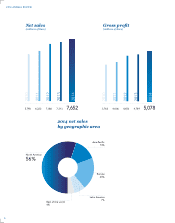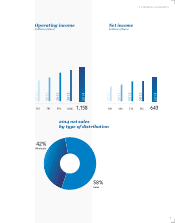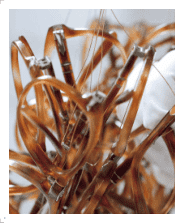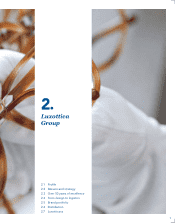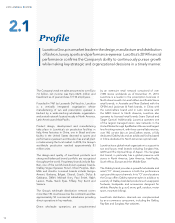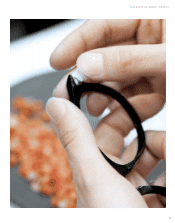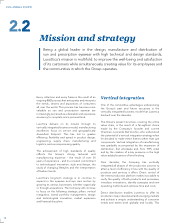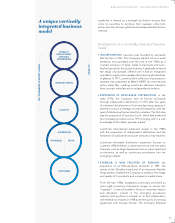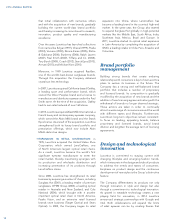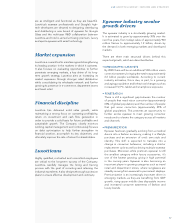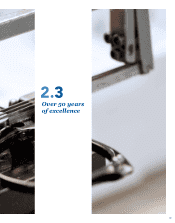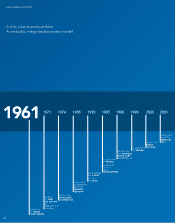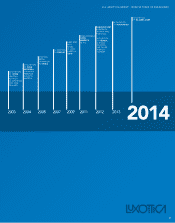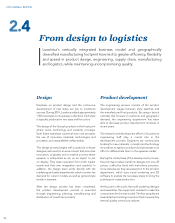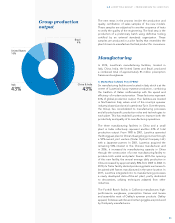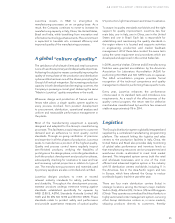LensCrafters 2014 Annual Report Download - page 18
Download and view the complete annual report
Please find page 18 of the 2014 LensCrafters annual report below. You can navigate through the pages in the report by either clicking on the pages listed below, or by using the keyword search tool below to find specific information within the annual report.that initial collaboration with numerous others
and with the acquisition of new brands, gradually
building the current world-class brand portfolio
and thereby increasing its commitment to research,
innovation, product quality and manufacturing
excellence.
Over the years Luxottica has launched collections
from names like Bvlgari (1997), Chanel (1999), Prada
(2003), Versace (2003), Donna Karan (2005), Dolce
& Gabbana (2006), Burberry (2006), Ralph Lauren
(2007), Paul Smith (2007), Tiffany and Co. (2008),
Tory Burch (2009), Coach (2012), Starck Eyes (2013),
Armani (2013) and Michael Kors (2015).
Moreover, in 1999 Luxottica acquired Ray-Ban,
one of the world’s best-known sunglasses brands.
Through this acquisition the Company obtained
crystal sun lens technology.
In 2007, Luxottica acquired California-based Oakley,
a leading sport and performance brand, which
owned the Oliver Peoples brand and a license to
manufacture and distribute eyewear under the Paul
Smith name. At the time of the acquisition, Oakley
had its own retail network of over 160 stores.
In 2013, Luxottica acquired Alain Mikli International, a
French luxury and contemporary eyewear company,
which owned the Alain Mikli brand and the Starck
Eyes license. As a result of the acquisition, Luxottica
strengthened both its luxury brand portfolio and
prescription offerings, which now include Alain
Mikli’s distinctive designs.
in
1995, Luxottica acquired the United States Shoe
Corporation, which owned LensCrafters, one
of North America’s largest optical retail chains.
As a result, Luxottica became the world’s first
significant eyewear manufacturer to enter the
retail market, thereby maximizing synergies with
its production and wholesale distribution and
increasing penetration of its products through
LensCrafters stores.
Since 2000, Luxottica has strengthened its retail
business by acquiring a number of chains, including
Sunglass Hut (2001), a leading retailer of premium
sunglasses, OPSM Group (2003), a leading optical
retailer in Australia and New Zealand, and Cole
National (2004), which brought with it another
important optical retail chain in North America,
Pearle Vision, and an extensive retail licensed
brands store business (Target Optical and Sears
Optical). In 2005, the Company began its retail
expansion into China, where LensCrafters has
become a leading brand in the country’s high-end
market. In the same year, the Group also started
to expand Sunglass Hut globally in high-potential
markets like the Middle East, South Africa, India,
Southeast Asia, Mexico, Brazil and Europe. In
2011, Luxottica started its optical retail expansion
in Latin America by completing the acquisition of
GMO, a leading retailer in Chile, Peru, Ecuador and
Colombia.
Brand portfolio
management
Building strong brands that create enduring
relationships with consumers is key to how Luxottica
plans to sustain its business in the future. The
Company has a strong and well-balanced brand
portfolio that includes a number of proprietary
and licensed brands. Its composition is gradually
modified by the acquisition of new brands and the
addition of new licensing agreements along with the
withdrawal of brands no longer deemed strategic.
These actions are taken in order to continually
attract a wide range of consumers around the world
with different tastes and lifestyles. Furthermore,
Luxottica’s long-term objectives remain consistent:
to focus on leading, appealing brands, balance
proprietary and licensed brands, avoid brand
dilution and lengthen the average term of licensing
agreements.
Design and technological
innovation
Luxottica is committed to staying current with
changing lifestyles and emerging fashion trends,
which it interprets in the design and style of products
to address the needs and tastes of consumers.
Emphasis on product design and the continuous
development of new styles is the Group’s distinctive
feature.
The Company differentiates its products not only
through innovation in style and design but also
through a commitment to technological innovation.
As growth in wearable technology creates a new
playing field for innovation, in 2014 Luxottica
announced strategic partnerships with Google and
Intel. Both collaborations will expand the limits
of what eyewear can be by creating frames that
2014 ANNUAL REVIEW
16


